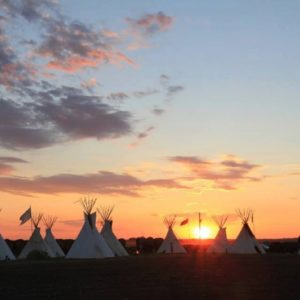All summer, news reports and video clips showed protesters of all ages, often highlighting teenagers from reservations around the country who came to North Dakota out of a feeling of solidarity with the Standing Rock Sioux. Now, at the end of October, school has started and many of them remain, putting the camp’s children and young adults at the center of a dispute over their educational status and raising questions as the protesters turn violent.
This week, tribal officials in North Dakota voted to build permanent structures on tribal land near the Dakota Access Pipeline protest. One of the buildings they plan to construct is a “homeschool resource center,” for the camp’s children. However, the state of North Dakota considers the project an illegal school and worries that the protesters may seek to have it accredited.
Alayna Eagle Shield, who works as a liaison between the local school district and the Defenders of the Water School, said in an interview with NPR that the school grew first from cultural concerns.
“When [the protest] very first started, all these people that were coming and picking up our chanunpa. It’s a sacred pipe and there is a protocol for how you handle that,” she said, explaining that tribal elders were concerned about native traditions after noticing that “people were doing things wrong.”
The goal at first was to “gather all these knowledge keepers and let them share their knowledge,” but as the protests lingered on into the fall the camp created a makeshift school of its own. Called the Defenders (or Protectors) of the Water School, it aims to provide education for students from kindergarten to eighth grade.
“Not only will their children be educated, they will not be charged with truancy,” said Eagle Shield.
Several news stories this fall focused on the makeshift school, highlighting it as a community success story and an example of a community pitching in to teach its children their traditions and heritage. The school started in early September and subjects taught include reading, writing, Lakota, math, physical activity, and community time.
Lacking much of the structure of a formal school, attendance varies from day to day, fluctuating from as few as 15 students to as many as 35. Since the school lacks the resources to offer classes at a high school level, most are in elementary school.
But is it really a school? While early reports called the community effort the camp’s school, more recent stories have described it as a “homeschooling resource center” or a school based on a homeschooling model.
However, the state of North Dakota is not so certain. In early October, Kirsten Baesler, the state superintendent of schools, sent a letter to Dave Archambault II, the chairman of the Standing Rock Tribal Council expressing her concern for the “educational well-being of students residing at the Sacred Stone Camp.”
“Both public and nonpublic schools must be state-approved,” Baesler wrote. “As you can tell by reading the section of code on school approval, completing the school approval process will likely take considerable time.”
Until the approval process is complete, she advised the camp leadership to “ensure parents enroll their children in a state-approved school,” and suggested that the schools in Mandan, ND would be closest.
In his response, Chairman Archambault described how the de facto school was created in a spirit of commitment to the educational rights of all children “to serve as a home education resource for the families residing at the camp.”
“The portrayal by the State Superintendent is a clear attempt to intimidate the families at Oceti Sakowin Camp and discourage them from making their own educational choices,” he said, adding that the school “has had no desire to become an accredited school at this time.”
While the school continues to operate, language used to describe the project on its crowdfunding page describes it as a resources for “the children and families of the protectors camp community who choose home education.”
However, even this shift in designation may not be enough to prevent children at the camp from running afoul of North Dakota law. State education statutes require that parents file a statement with their local school superintendent expressing their intent to homeschool “at least fourteen days before beginning home education or within fourteen days of establishing a child’s residence in a school district.”
Protests turned violent on Thursday as protesters set fire to highways, fired shots at police, and threw firebombs, which also raises questions about the safety of children at the encampment.

